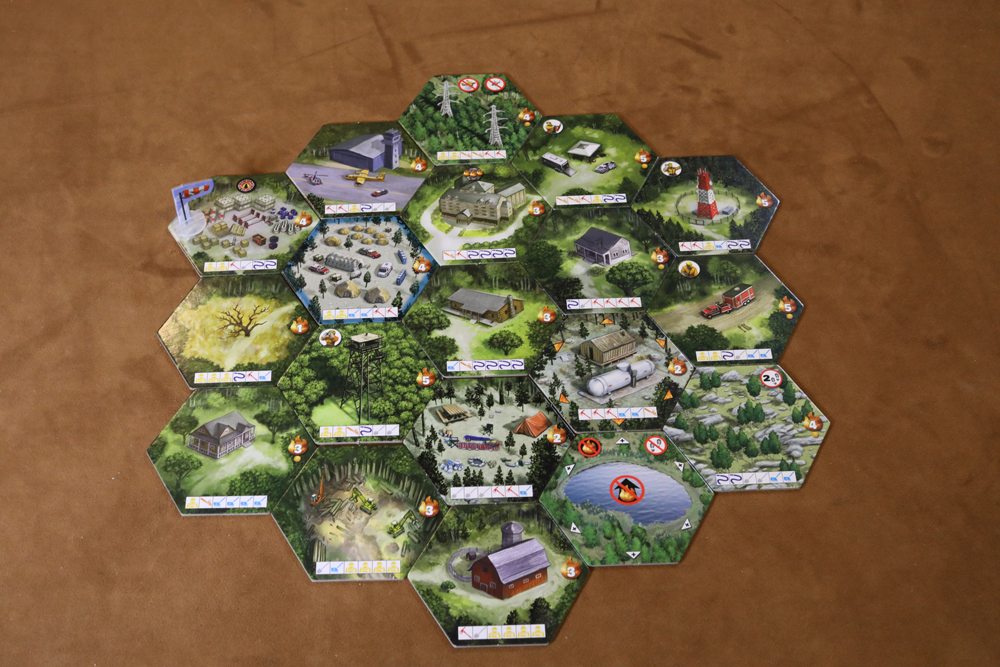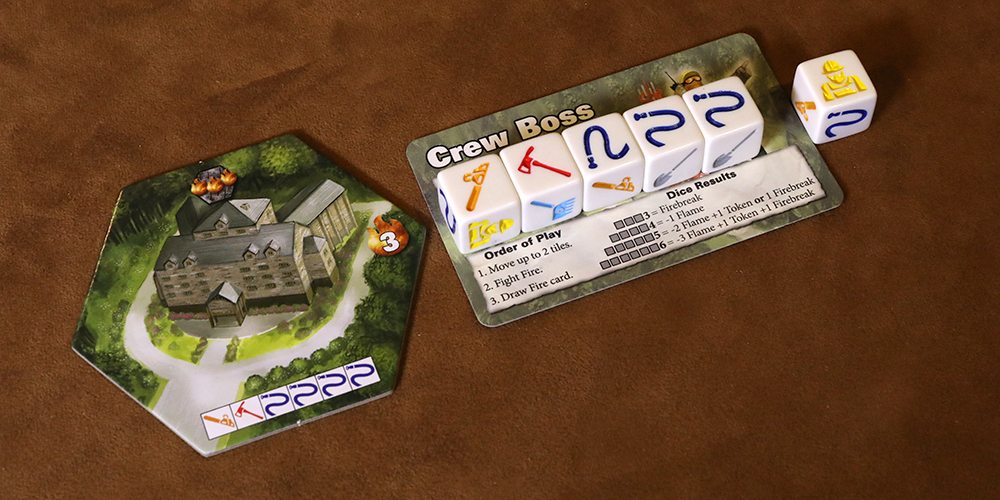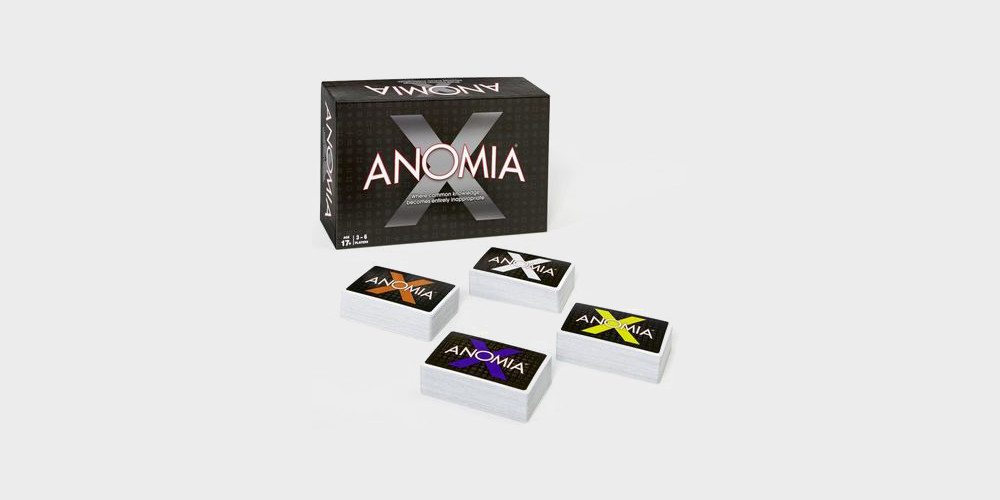
What Is Hotshots?
Hotshots is a cooperative, press-your-luck dice roller that has a bit of area control to it, also. It’s for 1-4 players, aged 10 and up and plays in about 60 minutes. In the game, players take on roles of firefighters, doing battle against forest fires. It’s a strategic game that delivers in thrills and anxiety and is from Fireside Games.

Hotshots Components
In the box, you’ll find:
- 19 Terrain hex tiles
- 4 Crew cards
- 15 Firebreak tokens
- 3 Vehicle tokens
- 4 Firefighter tokens and stands
- 16 Reward tokens
- 1 Wind marker and stand
- 29 Fire cards
- 6 Firefighting dice
- 25 Flame tokens
The terrain tiles are great. The artwork is really nice and the 3/4 perspective view evokes the feeling of flying low over a forest in a water bomber. They’re double-sided, with unique art on one side, featuring a location, effects, and play information on one side, and burned out (Scorched) ruins on the other. The quality is very good.
The Crew cards represent the four types of players in the game. These cards are also double-sided, with an available ability side and an exhausted ability side. The cards are linen playing cards and a bit longer than a standard bridge-sized card. The cards also provide information about order of play and what dice results mean, along with an action pose of the character.
All of the tokens are on cardboard, double-sided and nice. The fire cards are mini-sized and of equally decent linen quality. On one side is a fiery back, the other is the action that results from drawing the card — none of which are good, it’s just varying degrees of bad things.
The most impressive components are the dice and flame tokens. The dice are all identical with a different face on each side. Each face has a different tool for combatting the fire and each is engraved in a unique color. The neat thing about the dice is that the rule book celebrates (and educates) players about unique tools invented by firefighters and forest service rangers, both of which are included in the game. The flame tokens are translucent plastic and, when they catch the light just right, seem to glow like the embers of a fire just waiting to wreak havoc.

How to Play Hotshots
Setup
Setup requires a bit of decision after the first time you play, but the first time you play, just follow the suggestions in the rule book. Players will use all 19 Terrain tiles and you can set them up in any configuration you wish, but for the first game, it’s suggested you create one large hex shape with three tiles on each side.
Tokens are placed (mainly) on the side, with a few exceptions — vehicles on the Air Attack Base and the Wind marker pointing toward the top of the board and placed on the Fire Camp tile. Fire Deck cards are shuffled and starting Flame tokens are placed according to procedures in the rule book. Everyone gets a role and the corresponding Crew card and figure, which gets placed in the Fire Camp tile. After picking a first player, you’re ready to play.

A Few Things You Need to Know First
Tiles have a series of six icons at the bottom of them, except for the Lake tile. These are the die faces you must roll in order to fight fire on those tiles.
Each tile has a Scorch limit, that is the number of flames that can be on a tile before it is Scorched and flipped to its barren and burned out side.
Some tiles have additional iconography that allow special effects that help certain characters, but if these tiles are Scorched, so is the special ability for that character. When other tiles are Scorched other effects happen to the game. Most of them are bad. (Sense a commonality?)
On Your Turn
You can do three different things on your turn:
1. You don’t have to move, but you can move up to two tiles away. You can leave a burning tile, but you can’t move through a burning tile. You can’t move though the Lake tile and the Rocky Ground tile requires two movement to get through. Finally, you can move through Scorched tiles and Firebreaks, plus there’s no limit to how many people can be on a single tile.
2. After you stop moving, you can fight fire on the tile you’re on. This is done by rolling the dice and trying to match the icons at the bottom of the tile. Each time you roll, you must bank at least one die. As long as at least one face matches the tile, you may continue rerolling. You can stop rolling whenever you want, but you are only rewarded for matching at least three faces.

Based on your rolls, you get a graduating set of bonuses for the more faces you matched to the tile’s icons. You can pick up Firebreaks, which are immediately placed between the tile you’re on and any other non-Scorched tiles. Firebreaks prevent fire from spreading from one tile to the next. Players can also remove Flame tokens or gain Reward tokens, which, in a turn of events, all have good outcomes for the players. Each player may have no more than three Reward tokens and they can only be played by the active player on their turn.
If you’ve failed to match at least three icons when rolling the dice … we’re back to bad things happening. You must add a Flame token to the tile you’re on, possibly causing the tile to equal the flame limit of the tile and causing the tile to Scorch, another bad thing, which be explained shortly. A player rolling gains Support if there’s another player on the same tile or they are on a tile that’s adjacent to the Lake tile. This means that each Support they have (# of players on tile + 1, if adjacent to Lake), is an opportunity to roll again after a failed roll (no dice matching icons on tile).

3. Players then draw a Fire card. While moving and fire fighting are ostensibly optional, this last step is not. Regardless of what else happened on your turn, you must draw a fire card and resolve it. There are four types of cards in the Fire deck and most of them are going to work against you. There are Fire Increase cards, which cause either a single fire or multiple fires to increase. There are Wind cards, which cause fire to move from one tile to another. There are Ember cards, which start or intensify fires, and there are cards that will change the wind’s direction.
Most of these cards have some conditions that will dictate how much fire will be added to a tile or, sometimes, none at all. But each will have to resolved before moving on. This involves following conditions spelled out on the cards for adding fire tokens and then determining if the tile has reached its Scorched limit or not. If it has, the tile is flipped and only its Scorched side shows. Once a tile is Scorched, it is irretrievably damaged and lost for the game. You can still travel through it, but lose enough of them and you lose the game.
There are a lot of “if/then” statements that govern the Fire card and Scorching portion of the game and, rather than spell each out, I’ll just say that they are meant to level your playing experience and they aren’t that tough to play with. If you want to read what they are, the rulebook is here (PDF). See pages 6-7.

The Other Things You Can Do
Your character allows you to do some special tasks that other players can’t do. The abilities are pretty great and give players a big strategic advantage against the game. They fit the theme really well — Swamper and Sawyer can change die faces, Spotter can look at Fire cards before choosing one, and the Crew Chief can move a player. The clever thing is that there are tiles that, if lost, mean the characters no longer has their abilities. For example, if the lookout tower is lost, the Spotter can’t do his job. The Crew Chief can’t move people if the Radio Tower is lost. It all makes a lot of sense and really drives the theme home.
There are reward tokens that provide a variety of benefits and you can gain a randomly drawn token by rolling four dice with the same face or by matching enough faces on the tile. You can only ever have three, but they can save you when you’re surrounded by fire. Tokens can also be shared with a player on the same tile.
When you visit the Air Attack base tile, this is home to three different vehicles that can assist you in your efforts. There’s a Brush Rig, which allow you to place three continuous Firebreaks on the map. A helicopter is there to remove three fire tokens from a single tile and an Air Tanker will knock down a single fire token from three tiles. After playing any of these, your firefighter must be moved onto one of the effected tiles and the tokens for the vehicles are removed from the game.
Gameplay continues until either all flame tokens are removed, resulting in a victory for the players, or if eight tiles are Scorched or the Fire Camp is lost. In these cases, the players lose.
In addition to these rules, there are provisions to make the game more or less difficult, as well as rules for a single player game.
Why You Should Play Hotshots
At GeekDad, we’ve long been fans of Fireside Games. All their offerings are family friendly and enjoyable, and Castle Panic and its variants and expansions (read our review) is a game that we’ve been recommending since the day it came out. Simply put, Fireside just gets family gaming.
That said, Hotshots is a bit of a jog in a new direction for them. Despite the age recommendation, Hotshots is a step up in maturity for Fireside, I think. That’s not to say the game has anything inappropriate in it, nor am I saying the age recommendation is incorrect; I think it’s on the money. What I’m saying is that this is a more complex game from them and it’s a welcome challenge.
Hotshots is sure to draw comparisons to Flash Point, another cooperative firefighting game, albeit one that takes place in a house. While Flash Point is a great game, I think I like Hotshots better in most ways. With its modular tiles, each game is different and the randomness of tile placement (the replayability!) and Fire cards, Hotshots delivers desperate situations and demands anxious decisions about which fire to fight in the same way the outbreaks in Pandemic breed panic.
Unlike many cooperative family games, earning a favorable outcome every time you open the box is no foregone conclusion in Hotshots. In fact, you’ll likely lose your first few games. That’s ok, I think. We really enjoyed the challenge when we were playing. Before long, we were winning with consistency, but not without some sketchy moments where the outcome was in doubt.
I really appreciated how much thought went into incorporating the theme. How the fire spread, what each character was able to contribute, and how everything interacted made for a really nice gaming experience. Additionally, I loved that, after playing the first game, the book suggests a variety of other setup configurations, each meant to approximate the shape of a national park.
Wildfires are no joke and, to be honest, I feel a bit odd about reviewing this game in light of the lives and homes lost in California’s wine country last month. In fact, I sat on this review for a bit, waiting for a little time to pass after that disaster.
We really enjoyed Hotshots. We love the fact that it feels like a real step up from past Fireside games and found real entertainment in fretting over which fires to take on and the press-your-luck aspects of the game. If you’re looking for a fun challenge in a cooperative family game, check this one out.
Hotshots is from Fireside Games and is available now.

Click here to see all our tabletop game reviews.
If you’d like to stay up-to-date with all of our tabletop gaming coverage, please copy this link and add it to your RSS reader.
Disclosure: GeekDad received a copy of this game for review purposes.





